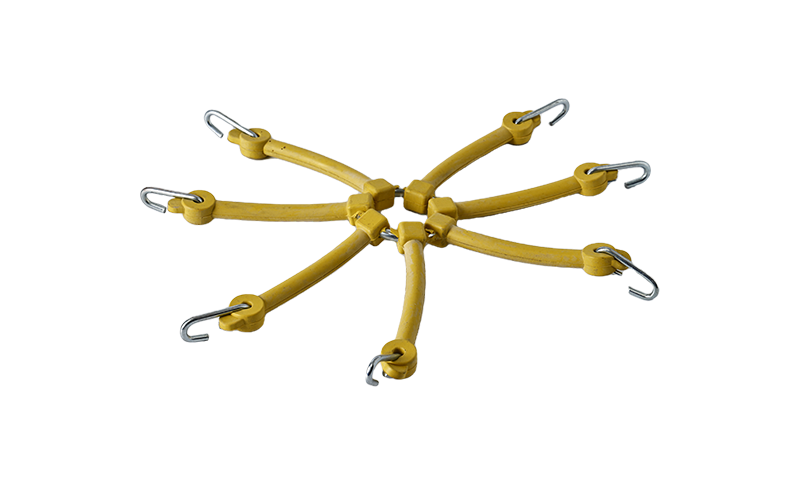Tire Chain Dobby Tensioner – A Vital Upgrade for Winter Driving
When preparing for winter driving, ensuring traction is one of the important safety measures. A tire chain dobby tensioner plays a crucial role in maintaining this traction, particularly on icy or snow-covered roads. Many drivers underestimate how much a properly tensioned chain can improve vehicle control, yet studies and field tests consistently show significant benefits.
Performance Benefits
Vehicles equipped with tire chain dobby tensioners experience measurable improvements in braking efficiency and handling. The same vehicle, when fitted with chains plus dobby tensioners, stopped in just 0.6 meters, showing a 66% improvement. In another test on sloped snow-covered terrain, a light SUV achieved 28% better lateral stability when using dobby tensioners compared to standard spring tensioners.
The key to this enhanced performance lies in consistent chain-to-tread contact. Loose links can cause chains to chatter, ride up on tire lugs, and create micro-skids. A tire chain dobby tensioner maintains flat chain positioning, distributing pressure evenly across the tire surface. This reduces uneven traction and improves vehicle control, particularly during sudden braking or sharp turns on slippery surfaces. Drivers often report that chains equipped with dobby tensioners feel more predictable and responsive in severe winter conditions.

Comparison with Other Tensioning Systems
Tire chain tensioners are available in multiple designs. Rubber donut tensioners are widely used for casual driving in light snow due to their affordability and ease of installation. Spider bungee tensioners offer moderate tension, making them suitable for mixed conditions and short commutes. Spring tensioners are designed for heavy-duty applications, maintaining high tension but requiring careful installation and more adjustment time.
Dobby tensioners provide unique advantages over these systems. Their design ensures even distribution of tension across the chain, reducing the risk of slippage or shifting during use. Unlike rubber donut tensioners, dobby tensioners maintain performance under cold and repeated use. Compared with spring-based tensioners, they offer smoother chain positioning and reduce wear on both chains and tires. This combination of stability, ease of use, and durability makes dobby tensioners ideal for both personal vehicles and commercial applications in snowy regions.
Durability and Material Considerations
Materials used in tire chain tensioners significantly affect their performance and lifespan. High-quality rubber, such as EPDM (Ethylene Propylene Diene Monomer), is commonly used because of its resistance to temperature extremes, moisture, and UV exposure. Dobby tensioners made from premium materials can withstand repeated use and maintain consistent tension for multiple winter seasons.
Durability directly impacts safety. Worn or low-quality tensioners may fail during use, causing chains to misalign and compromising traction. Tire chain dobby tensioners are engineered to resist stretching, cracking, and degradation, ensuring reliable performance even under challenging conditions. For commercial fleets operating in northern climates, these tensioners can reduce maintenance costs and downtime, offering both safety and economic benefits.
Market Trends
Recent data indicates that winter tire chain sales are projected to expand at a compound annual growth rate of over 6% through 2030, driven by demand for durable and easy-to-install tensioning systems. Consumers are shifting toward tensioners that are long-lasting, compatible with multiple chain sizes, and capable of maintaining performance in cold.
Conclusion
Upgrading to a tire chain dobby tensioner can significantly enhance winter driving safety, efficiency, and vehicle control.Drivers investing in this essential winter component gain more predictable handling, shorter stopping distances, and overall safer driving experiences. Tire chain dobby tensioners remain a vital upgrade for anyone navigating icy or snow-covered roads, ensuring consistent traction and peace of mind throughout the winter season.
NEXT:Rubber Seal: Trends, Technologies, and Industrial Applications
Related Products
-
 View More
View More
Industrial Flat Nature Tarp EPDM Rubber Strap with Hooks
-
 View More
View More
100% EPDM 9"/10"/15"/21"/31"/41" Rubber Tie Down Tarp Straps with S Hook
-
 View More
View More
7-wire hook light truck tire chain dobby tensioner
-
 View More
View More
Blue multi- arm tighteners for light truck tire chain with 6 wire hook
-
 View More
View More
JB-21 Rubber Foot Pad, Cargo Bar Pad
-
 View More
View More
Plastic/Rubber Bundled Cargo Stepping Board


